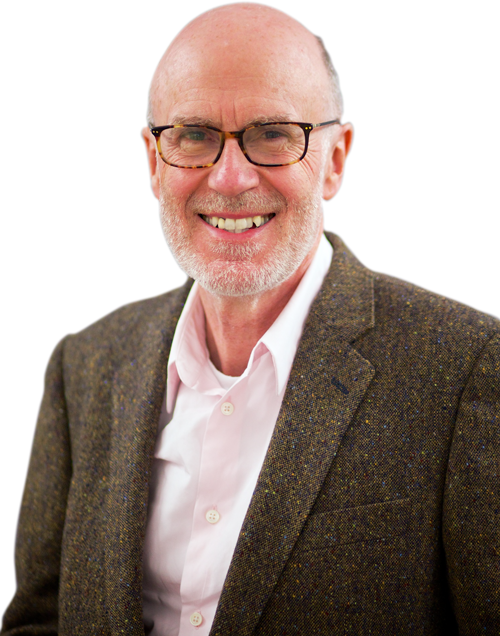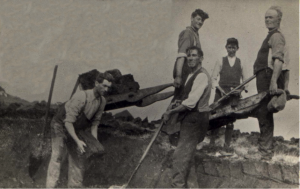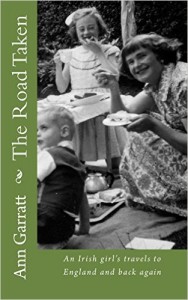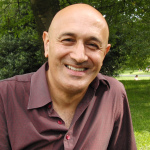Biologist & Writer

About
I was born in Donegal, Ireland

Legend: My grandfather (far right) and family members cutting peat in Donegal bog. The photo puts me in mind of Seamus Heaney’s line from his poem, Digging, ‘By God, the old man could handle a spade/Just like his old man.’
but when aged about 5 my family emigrated to Coventry, in the West Midland industrial hearthland of the UK. My sister, Ann Garrett, has written a very engaging account of the family’s move and subsequent life in Coventry, ‘The Road Taken‘.

We lived in a rather run-down, bomb-patched, area of Coventry, Hillfields where I attended the local St Mary’s Primary School and then Bishop Ullathorne Secondary School before escaping to London in the late 1970’s to go to University first at Bedford College then to do my PhD at Imperial College, University of London.
My Paid Work
After graduating with a degree in Biochemistry from Bedford College, University of London I went to do a Phd on fungal virus genetics working with Ken Buck at Imperial College.
I then went on to my first post-doc at St Mary’s Hospital Medical School with Professor Bob Williamson on human genetics.
St Mary’s was as a terrifically stimulating environment at the time where I worked with loads of very clever people but, if the truth be told, my project didn’t go well so after a couple of years I went on to another post-doc at St. George’s Hospital Medical School to study Crohn’s disease with the surgeon John Hermon-Taylor. This went a lot better and I went on to investigate the role of mycobacteria in this disease, work which took me on to the University of Surrey where I gained a lectureship in Molecular Microbiology working first on paratuberculosis in cows and humans, then tuberculosis and meningococcal meningitis in humans. My group now specializes in using systems-based approaches to study infectious disease.
Writing
I wrote the popular science book, Quantum Evolution, published in the UK by HarperCollins in 2001, in the US by Norton in 2002 and by Kyoritsu Shuppan in Japan in 2003. The book examines the role of quantum mechanics in life, evolution and consciousness.
I have allways had an interest in literature as well as science and, with Robin Headlam-Wells I wrote Human Nature: Fact and Fiction in 2006 with contriubutions from Philip Pullman, Ian McEwan, Steven Pinker and others examining how science and literature contribute to our understanding of human nature.
I also write articles regularly for the Guardian newspaper in the UK on topics as varied as quantum mechanics, evolution and genetically modified crops, and occasionally review books for the Guardian. The Washington Post and Frankfurter Allgemeine Sonntagszeitung have also published my articles.
My latest book, Life on the Edge: The Coming Age of Quantum Biology, written with Jim Al-Khalili is published by Bantam Press in 2014 in the UK and will be published in the USA by Random House in 2015.
My Interest in Quantum Biology
In 1988 John Cairns, Julie Overbaugh, and Stephan Miller published a paper entitled “The origin of mutants,” in the leading science journal Nature, in which they suggested that starving bacteria could choose which mutations to make, contrary to neodarwinian evolutionary theory and the central dogma of molecular biology that information goes outward from the genome to the cell and its environment and not the other way. The paper caused a storm in genetics circles and released an avalanche of letters to Nature attempting to come up with some sort of explanation.
As a bacterial geneticist I found the observations described by John Cairns (a very eminent US geneticist) intriguing and profoundly puzzling. At the time I had been reading Schrödinger’s Cat by John Gribbin which provides a very accessible account of the strange world of quantum mechanics and particularly the measurement problem and how it seemingly allows observers to influence the outcome of experiments. I couldn’t help wondering whether something like this was going on in Cairns’ experiments with the starved E. coli cells acting as the observer of their own genome.
After a lot of thought I came up with back-of-the envelope mechanism involving quantum tunnelling of coding protons in the DNA double helix which seemed to make sense to me but I was very aware that my knowledge of quantum mechanics was very rudimentary. I thought the only way forward was to present my ideas to physicists and so I contacted the Physics Department at Surrey and rashly agreed to give a seminar on the topic.
After an hour or so in the lion’s mouth of the Physics seminar room I dusted myself off and limped towards the door. My ideas had been politely but (justifiably) sceptically received and the many problems with my speculative ideas had been made apparent. However, before leaving the room one of the audience, theoretical particle physicist Jim Al-Khalili, came up to me and offered to help me put some more sturdy quantum legs on my speculative idea.
Over several years we would occasionally meet over a coffee or a pint to discuss an idea before knocking it down and moving on to another. Eventually though we had something that we thought could, with an awful lot of ifs and buts, work. We wrote up a paper, ‘A Quantum Mechanical model of adaptive mutations (mcfadden_and_al-khalili_1999) that was published in the journal Biosystems in 1999.
In truth, although our paper has now been cited 78 times, it did not make many converts. Part of the problem was adaptive mutation became messy and it became less clear that anything exotic was needed to account for them (see excellent review by Patricia Foster here).
However, the more I read and thought about the topic the more I became convinced that weird aspects of quantum mechanics do indeed play an essential role in our cells so I went ahead and wrote Quantum Evolution, published by HarperCollins in 2000 and Norton in 2001, proposing that quantum biology was central to life and evolution. However, although the book was well-received, it did not convince many scientists, particularly biologists who, when told for example that particles can be in two places at once would insist that ‘not in my cells they can’t’. In the early 2000’s it remained pretty much an admission of mental illness to claim that quantum mechanics was doing anything interesting in biology.
Talking about madness, I developed an interest in consciousness around this time. This came about because I had planned a chapter in Quantum Evolution that would describe the theories put forward by mathematician Roger Penrose and anaesthesiologist Stuart Hamerhoff which claimed that consciousness was a product of quantum coherence in microtubule proteins. However, when I came to writing the chapter I found that I just couldn’t believe that the very busy and dynamic microtubules could maintain delicate quantum states. So I was left with a chapter without a topic. However, all that ruminating about the deficiencies of the Penrose-Hamerhoff theory did force me think a lot about the problem of consciousness which stimulated me to come up with my own idea, the cemi field theory, which proposes that the seat of consciousness is the brain’s electromagnetic field (simple as that!). You can find more about the theory here.
Following the fairly frosty reception to our propoosal that quantum tunnelling was involved in mutation, both Jim and I went back to our paid research on particle physics and microbial genetics respectively and would occasionally meet to discuss any new idea or paper that looked interesting. Then in 2007 a paper from Graham Fleming’s laboratory at Berekley came out with the jaw-dropping (at least for me) title, ‘Evidence for wavelike energy transfer through quantum coherence in photosynthetic systems’, which provided sound experimental evidence for quantum coherence at the heart of the most important biochemical reaction in the biosphere. It wasn’t long before these results were confirmed by many other labs and new papers came out on almost an almost monthly basis describing strong evidence of quantum tunnelling in enzymes, quantum entanglement in avian navigation and even quantum tunnelling in smell.
Almost overnight, an interest in quantum biology went from being a sign of madness to almost respectability. A few years ago both Jim and I organized a workshop on this topic at the University of Surrey and thereafter separately embarked on writing books describing developments in this exciting new field. But sometime in 2012 returning from having a coffee/chat Jim related what his plans were for his first chapter – a story about bird migration – which sounded a lot like my own Chapter One. Concerned that he might think I had stolen his idea I sent him the my draft chapter that evening and the next morning he called to suggest that we pool resources to write the book that eventually became, ‘Life on the Edge’.
Since then we have revived our old interest in quantum tunnelling in mutation and are attempting to discover whether or not it really is going on within the DNA of our cells using both theoretical and experimental approaches.
